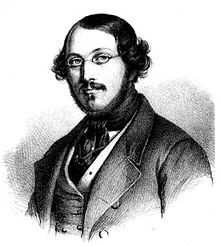Georg Carstensen
Johan Bernhard Georg Carstensen (born August 31, 1812 in Algiers , † January 4, 1857 in Copenhagen ) was a Danish officer and businessman. He was the founder of three Copenhagen entertainment establishments: " Tivoli ", "Casino" and "Alhambra".
Life
Carstensen's father was a diplomat and in 1812 the Danish consul general in Algiers. Georg Carstensen spent a large part of his childhood in the Orient . After a period of long journeys, Carstensen decided to take up the officer career, which he ended as a lieutenant.
1835-1837 he traveled to Spain , Morocco and Algeria. From 1837-1838 he went to the USA via Paris . Then Carstensen returned to Copenhagen via England and France . There he published a literary and art magazine Portefeuillen from 1839–1841 and then a Figaro (1841–1842). Large banquets with music and fireworks were organized for Carstensen's subscribers for advertising purposes . The place of the festivities were the Königsgarten (Kongens Have), Classens Have or the riding school of Christiansborg Palace . Mostly Hans Christian Lumbye acted as musical director and conductor .
Due to the success of these festivals, Carstensen asked King Christian VIII for the privilege of setting up an amusement park modeled on Vauxhall Gardens in London. "If the people are enjoying themselves, they don't make a revolution," Carstensen is said to have argued in a personal audience with the king - and this argument is said to have particularly impressed the king. In 1843 Carstensen received a five-year permit to operate a so-called Tivoli under the name Kjøbenhavns Tivoli og Vauxhall . The amusement park opened its doors on August 15, 1843. Carstensen himself had designed most of the (wooden) buildings, but practically nothing of their original condition has survived today.
After the Tivoli as a summer festival location, Carstensen tried in 1847 to create a "Winter Divoli", the "Casino". This soon went bankrupt, however, and was converted into a popular theater. In 1848 Carstensen took part in the Schleswig war, but was deposed from the management of the Tivoli Society. The imaginative, adventurous man was considered a spendthrift and unsuitable for everyday business.
After the falling out over Tivoli, Carstensen enlisted in the army in the Danish West Indies for four years . In 1852 he traveled to New York and designed the New York Crystal Palace with Karl Gildemeister for the Exhibition of the Industry of All Nations (1853) . In 1855 he returned to Copenhagen and tried to build the Alhambra Garden in Frederiksberg to compete with Tivoli . However, he died before the project was completed. This company ended as a fiasco, partly because of the poor heatability of the large hall. The investors in the project lost their money, but the Alhambra was continued by others until 1869 and then demolished. Carstensen also designed one of Copenhagen's first tram projects in 1856.
He is buried in the Kirkegård garrison in Copenhagen. Hans Christian Andersen dedicated a farewell poem that touches the heart to the early deceased.
literature
- Per Eilstrup, Ellen Dahl: The Story of the Fairytale Garden . Tivoli AG, 2005
- Steen Kristensen: Georg Carstensen - Tivolis founder . (Danish)
- Elisabeth Oxfeldt: Nordic Orientalism. Paris and the Cosmopolitan Imagination 1800-1900 . Museum Tusculanum Press, Copenhagen 2005, ISBN 87-635-0134-1
- Alhambra . In: Christian Blangstrup (Ed.): Salmonsens Konversationsleksikon . 2nd Edition. tape 1 : A – Arbejdergilder . JH Schultz Forlag, Copenhagen 1915, p. 504 (Danish, runeberg.org ).
- Carstensen, Georg Johan Bernhard . In: Christian Blangstrup (Ed.): Salmonsens Konversationsleksikon . 2nd Edition. tape 4 : Bridge-Cikader . JH Schultz Forlag, Copenhagen 1916, p. 607-608 (Danish, runeberg.org ).
- Edgar Collin: Carstensen, Georg Johan Bernhard . In: Carl Frederik Bricka (Ed.): Dansk biografisk Lexikon. Tillige omfattende Norge for Tidsrummet 1537-1814. 1st edition. tape 3 : Brandt – Clavus . Gyldendalske Boghandels Forlag, Copenhagen 1889, p. 409-410 (Danish, runeberg.org ).
Web links
- Quotation reference to popular amusement as a means against political unrest. Google Books
- about Carstensen. Tivoli website (Danish)
- Carstensen's grave
- Plaan the tram line
- Memories of Carstensen
Individual evidence
- ↑ “Naar Folket morer sig, laver det ikke Revolution, Ds.Majestaet”, quoted in Oxfeldt, p. 67.
- ↑ Peder Bundgaard: København - you are old . Borgen Verlag, Copenhagen 1996, ISBN 87-21-00499-4
| personal data | |
|---|---|
| SURNAME | Carstensen, Georg |
| ALTERNATIVE NAMES | Carstensen, Johan Bernhard Georg (full name) |
| BRIEF DESCRIPTION | Danish officer and entrepreneur |
| DATE OF BIRTH | August 31, 1812 |
| PLACE OF BIRTH | Algiers |
| DATE OF DEATH | January 4, 1857 |
| Place of death | Copenhagen |


